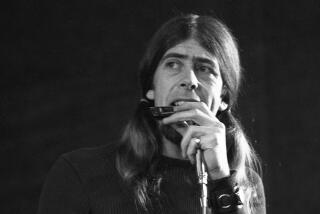All You Need Is . . . ‘The Rhythm of Life’
The scene in Hermosa Beach was redolent of an epochal moment in music: The band was cooking, the dance floor was jammed and Sir George Martin was standing in the corner, taking it all in.
It was reminiscent of the Cavern, the steamy and chaotically joyful teen hotspot in Liverpool where the Beatles were playing one night in 1962 when Martin first laid his piercing blue eyes on them. That night, he decided to offer them their first contract, and he went on to produce all their records before their 1970 breakup. Along the way George Martin was dubbed “the fifth Beatle,” thereby, with his eventual knighthood, entering an indelible chapter in music history.
For the record:
12:00 a.m. April 20, 1997 FOR THE RECORD
Los Angeles Times Sunday April 20, 1997 Home Edition Calendar Page 87 Calendar Desk 1 inches; 30 words Type of Material: Correction
The Beatles--George Martin signed the Beatles to a recording contract after a 1962 audition, not after a Cavern club performance, and Phil Spector produced the “Let It Be” album. A Film Clip last Sunday was in error.
While on a recent Saturday afternoon the Ragin Cajun Cafe was hardly the Cavern, the electricity of artist connecting with listener nonetheless charged the air. A crew Martin had brought from England was taping a segment for “The Rhythm of Life,” a three-part documentary to be aired this fall on the Discovery Channel that will be the 71-year-old composer and studio genius’ musical autobiography.
On stage was Lisa Haley and the Zydekats, a Los Angeles group blending traditional Cajun forms into a blues- and rockabilly-flavored sound that has attracted some enthusiastic followers, a few dozen of whom had crowded into the small restaurant.
“If it is not good music, it doesn’t move people,” said Martin, who heard about Haley from a British Broadcasting Co. stringer who saw the Zydekats last year at a concert in Santa Barbara. “I think good music moves people emotionally, makes them want to get up and dance and feel good.”
Martin was taping Cajun music here instead of New Orleans because he wants to show, among other things, how traditional music evolves in the interaction of artist and listener. “In America there is such a melting pot,” he said. “If you go anywhere in America you can find any [kind of music] and it’s always something different.”
Here at the Ragin Cajun, he found Haley, a fourth-generation Mississippi Delta fiddler, who doesn’t pretend to replicate the acoustic roots music popularized by the late zydeco king Clifton Chenier. But that’s fine with her fans, who favor her electrified sound that retains Louisiana fiddle and accordion flavorings and traditional syncopations.
“She has her own style,” said Patrick Dalcour of San Diego, a Lafayette, La., native who recalls watching Chenier perform back home. “Lisa is about as authentic as you can get for the West Coast . . . all of her music is danceable.”
Schoolteacher Joyce Richoux of Torrance, a New Orleans native who paused at the bar to grab a bottle of Louisiana-brewed Dixie beer, pointed out that dancing is an inextricable part of the Cajun sound: “This music is not a spectator sport.”
This will be Martin’s biggest project in three years, since he mixed “The Beatles Anthology”--an updated collection of recordings interspersed with interviews and outtakes. Haley in turn said she was intrigued by questions Martin’s producers asked during interviews for the show, “things no one has ever asked me before, such as when it’s coming up time for you to take a solo, what goes through your head? [And] how do you know that you’re playing a solo that people are going to enjoy?”
Such inquiries broach the very heart of the relationship between artist and listener: artist senses that her listener is being moved and adjusts her performance accordingly.
Outside the Ragin Cajun, Martin, the classically trained composer and arranger, reflected on music that he finds particularly moving.
“There are so many pieces . . . [Sergei] Rachmaninoff or [Peter] Tchaikovsky’s Sixth Symphony. I will be just taken away to somewhere else. In popular music, too, you can get a song that really moves one to tears. That is the great thing about music, the ability to raise the hairs on the back of your neck, to give you that excitement, that magic.”
Martin also appeared genuinely moved when reminded that a Southern California radio station, KGIL-AM (1260), airs an all-Beatles format.
“I just heard about it,” he said. “It’s amazing, isn’t it? It really is amazing. It goes on forever.”
A nearly three-hour set in which Martin had Haley play one of her standards, a traditional song titled “I Gotta Secret” at least four times, left the dancers, Richoux and Dalcour among them, limp when the hot lights were finally switched off.
“What we were doing here was enormous fun,” Martin said as Haley packed away her equipment. “And the most significant part of it is that it makes people want to get up and enjoy themselves, and that is one of the essences of music. Music makes people feel better, and that’s why I guess I’m in it.”
More to Read
The biggest entertainment stories
Get our big stories about Hollywood, film, television, music, arts, culture and more right in your inbox as soon as they publish.
You may occasionally receive promotional content from the Los Angeles Times.










